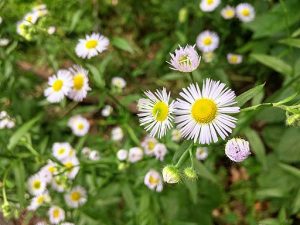Every year about this time, I grapple with the dilemma of what to weed. It’s not that I want my garden to be overrun with volunteers, but over the years I’ve become more and more averse to killing living things. This includes plants, with which I’ve always had an affinity. I think I was a plant in a former life, and probably something weedy.
This year’s problem plant is a grove of daisy fleabane which seeded in on barren ground near where I had misguidedly let their mother bloom the year before. There they all are, her strong and healthy children, forming their sturdy basal rosettes with taproots to Eden. Part of me says, pull ’em up. Another part doesn’t feel like it — I tried pulling one up by the roots the other day and it wouldn’t budge. But the strongest part of me, the part that has the upper hand at the moment, is suffering moral pangs at the thought of all those soon to be dead plants in a pile next to my empty flower bed.
Still unable to make up my mind, I decided to do some research in hopes of finding a rational reason for allowing several dozen daisy fleabane plants to grow to maturity in what is otherwise a perfectly good, albeit shady, flower bed.
First, I got out Weeds of the Northeast, an invaluable guide to all the plants that wildflower books leave out. I browsed all the similar plants, and when I got to the fleabanes, I knew I had my weed.
Online, the only people other than landscapers who talk about daisy fleabane are weirdos like me. Chiefly, these are the wild gardeners who include nature in their gardens. One of their lot said that daisy fleabane was a benefit to her garden, especially when allowed to seed in among other seasonal blooms. In my case, these include the equally weedy but more attractive Dame’s Rocket, whose purple blooms are set off nicely by the bluish white of the fleabane.
Another commentator said that daisy fleabane will handily fill empty beds but gives way cheerfully to other plants when introduced. I appreciate that spirit of cooperation in a plant.
The evidence was mounting. Daisy fleabane was not the horticultural menace I had feared.
On a whim, I also looked up its medicinal properties. Not surprisingly, daisy fleabane, which is a native plant, has been used medicinally for centuries starting with the Native Americans. It’s held to be antioxidant, anti-inflammatory, and astringent, and has been used to treat ailments from the flu to cancer. As its name suggests, it was also used to repel fleas, which one imagines was especially valued back when fleas were the source of much pestilence… *
All things considered, the daisy fleabane, humble though it be, has many virtues to recommend it, or at least, more than I would ever have guessed at first glance. So my plans vis a vis the daisy fleabane have changed. I’m going to let a lot of it go and only weed out those plants that are crowding plants I’d like to have instead — evening primrose, lemon balm, and a small plantation of burdock which I grow for their roots.
Once the bed is under control, I’m going to let the fleabanes do their thing, and see how it goes. I’ve also decided that given their number, I have permission to remove more in the future if I need the space for something else. In short, I’m going to be flexible about it and give myself a moral out by saying that I’m merely thinning for the benefit of all rather than performing an out and out massacre.
Having gone through the weeding process more than a few times in my life, my appreciation for weeds deepens. Unlike our lush, hybridized species — the garden phloxes and alyssum, poppies and peonies, these plants are the real deal. They haven’t had any part of themselves hybridized away by unnatural selection. They retain all their properties and, I think, a bigger share of life force. Consider how much harder it is to grow hybrids than a stand of hardy weeds.
Moving into the spiritual realm, perhaps they are here to teach us something. Maybe creating a little habitat in our own backyards will make the birds and bees happy. What if learning about our weedy brethren contributes to our own awareness of nature. The possibilities are numerous. And that’s why I say: have pity on the weeds. Even the most unprepossessing plants can have benefits.
* Disclaimer: Remarks about reputed medicinal benefits of daisy fleabane are included for informational purposes and only and not intended as a recommendation! but you knew that.
Photo credit: Nucleosynth / CC BY-SA






Sweet Brother Weed
The soundtrack here should be “Sweet Brother Weed” a modern shape-note-style song by Vermont’s own Don Jamison of the Social Band (on YouTube: https://www.youtube.com/watch?v=jxR2zM6cNBo).
First Verse:
Sweet brother weed, whom none must judge,
teach us to feel God’s grace,
as you the wind, whose lightest nudge
lifts you to dance in place.
Yes, indeed!
Thanks for this lovely piece, Lise. I’m not even a gardener (!), but will send this on to family and friends who are. Love your thoughts on this.